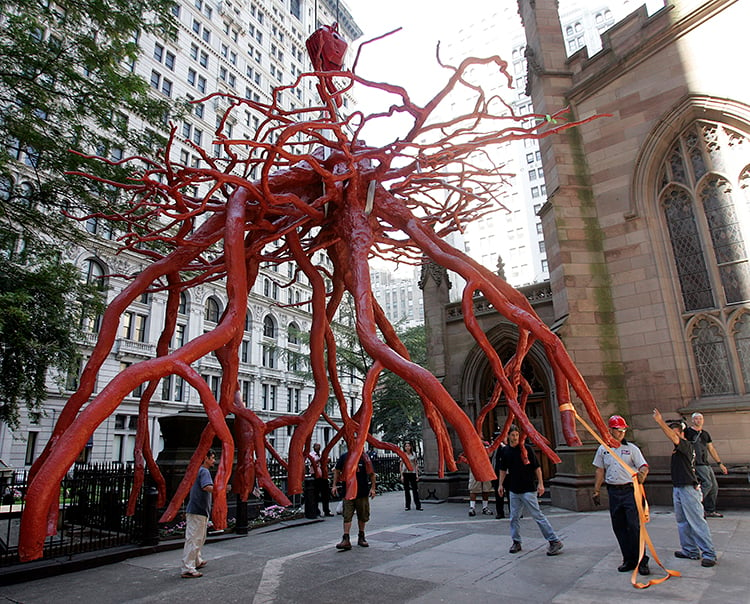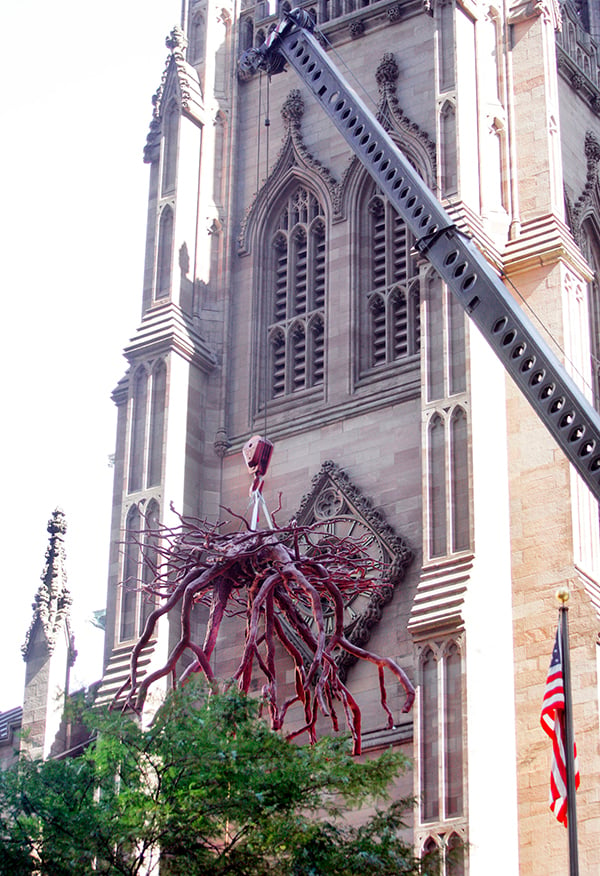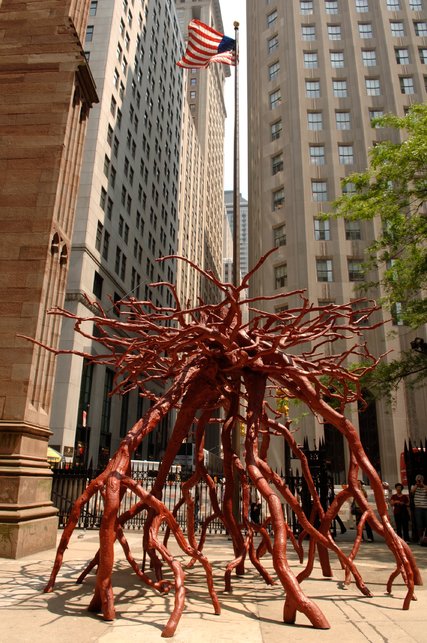Art & Exhibitions
Artist Outraged After 9/11 Memorial Damaged in Covert Removal
It was intended to be a permanent monument.

It was intended to be a permanent monument.

Sarah Cascone

On September 11, 2001, a massive sycamore tree that stood in Lower Manhattan at Trinity Church’s St. Paul’s Chapel was among the many casualties of the World Trade Center attacks. Sculptor Steve Tobin created Trinity Root, an 18-foot-tall, three-ton bronze inspired by that tree, as a memorial to the tragedy, donating it to the church in 2005.
Now, however, reports the New York Times, Tobin has been dismayed to learn that the artwork, intended as a permanent monument, is no longer at the site. The church moved the sculpture to a conference center it owns in West Cornwall, Connecticut, in December, damaging the piece in the process.

Steve Tobin with Trinity Root, the 9/11 memorial he donated to Trinity Church. Courtesy of Steve Tobin.
The artist only learned of the work’s removal after the fact, while attempting to arrange to refresh the patina of the sculpture, which had become dirty after a decade of exposure to the elements and caressing hands of visitors. Tobin alleges that Nathan Brockman, his contact at the church, told him that they were looking into moving the sculpture.
“I said, give me some time to find a suitable location,” Tobin told artnet News in a phone conversation. In the meantime, he decided to take his kids to see the piece for the first time, and informed Brockman that he would be stopping by. “It was was only then that he confessed that the piece had already been moved, under the cover of night! Imagine if I took my kids to see it and it was already gone?”

Guided by workmen, Steve Tobin’s Trinity Root sculpture is lowered into place by a crane in the Trinity Church yard September 8, 2005 in New York. Courtesy of Stephen Chernin/Getty Images.
The monumental work took 20,000 hours to complete, and involved 200 separate castings based on the stump and root system of the ruined tree. “So many people pitched in—to have it treated like this, it’s an assault on the victims of 9/11,” Tobin said. “I took no money, no sponsors to make it,” he added.
The artist recently donated an early maquette model of Trinity Root to New York’s National September 11 Memorial Museum.
The artist suspects the personal preferences of Trinity’s new rector, William Lupfer, who took office in February 2015, were behind the artwork’s deinstallation. “What I heard, he said, ‘This is ugly, what is it? get it out of here!'” Tobin claimed. The artist was “shocked” by the eventual revelation that the memorial was no more. “I don’t know how they can right this wrong.”

Steve Tobin, Trinity Root. Courtesy of Steve Tobin.
In response to inquiry from artnet News, Trinity Church sent the following statement in an email:
We respect Mr. Tobin as an artist and his body of work. The original, signed agreement between Trinity and Mr. Tobin never discussed a permanent installation. After great consideration and after notice to the artist, the Root was relocated from the south churchyard, a space that has been used in many different ways over the past 300 years. Freeing up the south churchyard allows us to be more flexible with our many ministries. For example, as part of Trinity’s Art As Advocacy mission, Another Day Lost, a mixed media installation depicting the Syrian refugee crisis, was installed with the hope that it would draw attention and support for increasing the number of Syrian refugees to the United States. We relocated the Root to the Trinity Retreat Center in Connecticut in a place of respect and contemplation. Some minor, reparable damage did occur to the sculpture as an unforeseen consequence of the move. We have repeatedly offered to return the sculpture to Mr. Tobin and relocate it to another site of his choosing, at no cost to him, but he has not responded to our offer.
“I was told that this was going to be there forever,” Tobin insisted, saying that was the language used in press releases and news articles at the time. The New York Times, for instance, called it “the first substantial permanent [9/11] memorial in the area” in a 2005 article.
While Trinity Root was meant to be site-specific, Tobin says he would have cooperated in having it moved to another site in Lower Manhattan. At the very least, he wishes there might have been some kind of ceremony to celebrate it the piece before it moved on to the next stage of its life.
Despite the damage to the work, Tobin is hopeful that Trinity Church may still reconsider its decision. “So many people took solace in this piece,” said Tobin. “Let’s see what the community can do to rally behind it.”